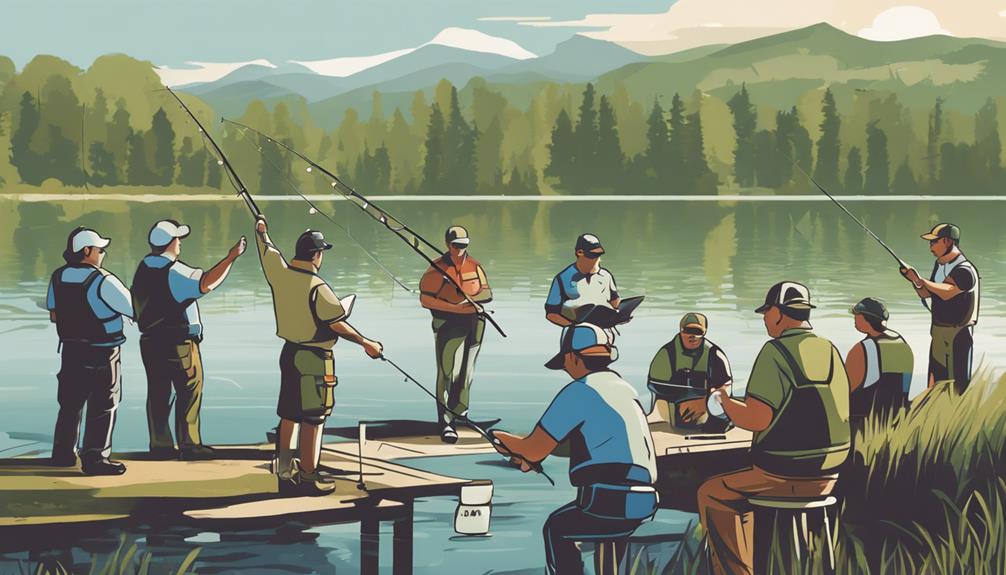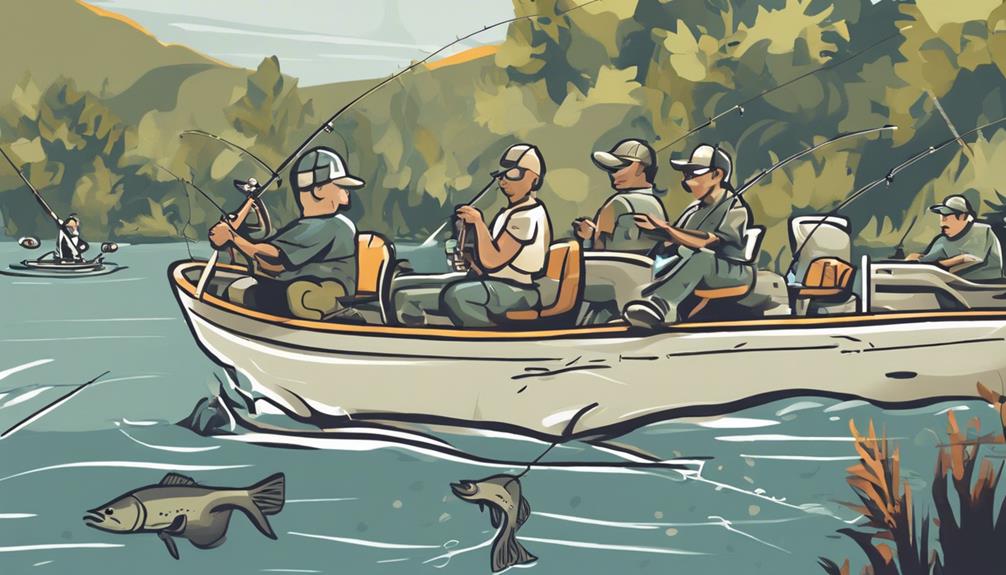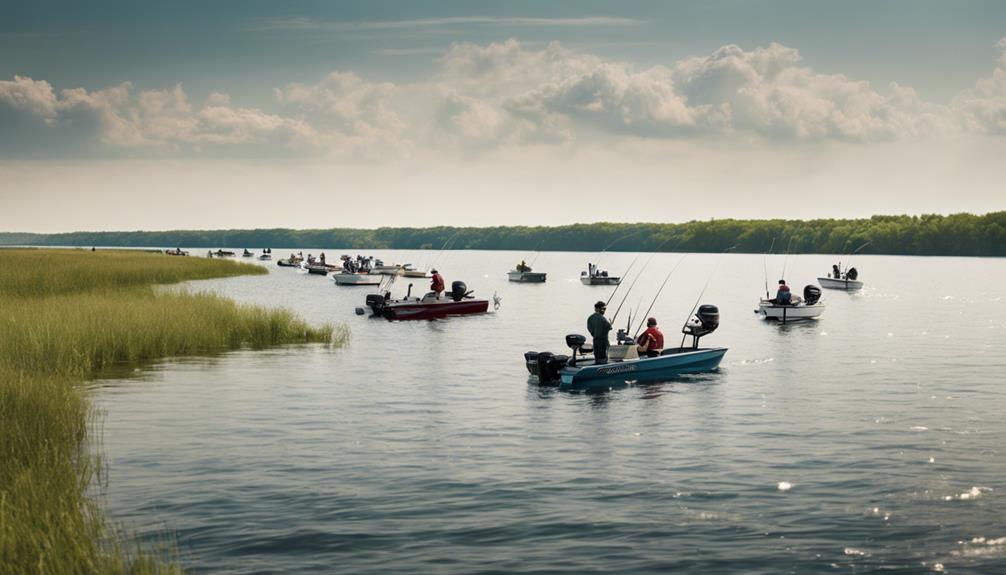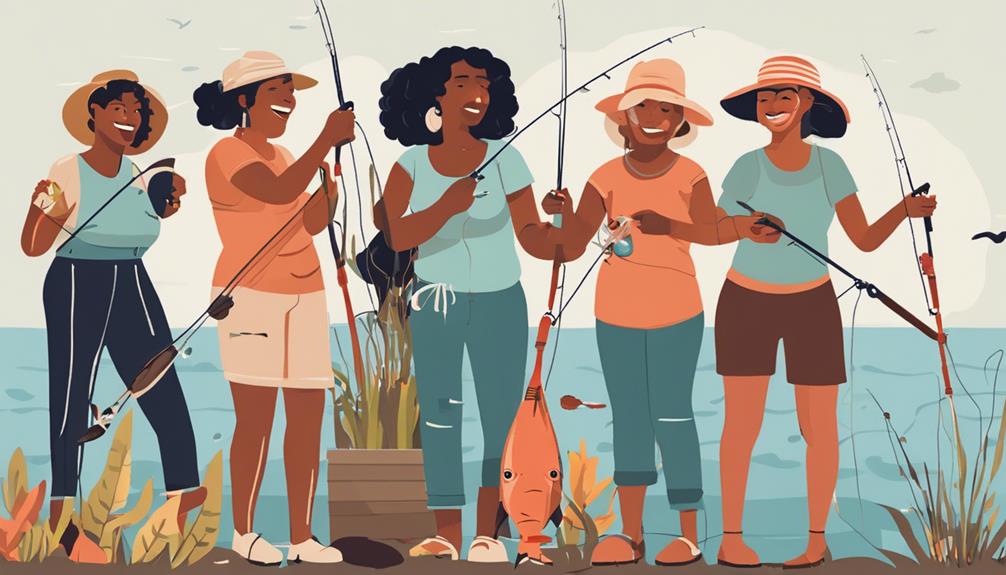In fishing tournaments, you must meet eligibility requirements like age limits and registration procedures. Follow guidelines on fish species, equipment rules, and catch-and-release practices. Adhere to strict weigh-in protocols for precise measurements. Ensure boat safety with proper maintenance and necessary gear. Abide by boundary limits to conserve wildlife and maintain fairness. Embrace time limitations and use approved bait and lures. Uphold rules or face disqualification. Respect the environment and fellow anglers with good etiquette. Be prepared with weather plans, fair prize distribution, and protest procedures. Master these 15 key rules for success in fishing tournaments.
Tournament Eligibility Requirements
To participate in fishing tournaments, anglers must meet specific eligibility requirements established by tournament organizers. Age requirements vary depending on the tournament, with some allowing anglers as young as 12 to participate, while others may require participants to be 18 or older. The registration process is crucial, typically involving submitting an application form, paying an entry fee, and sometimes attending a pre-tournament meeting where rules and regulations are discussed.
Qualifying fish species and size limits are essential aspects of tournament eligibility. Most tournaments specify which fish species are eligible for competition, such as bass, trout, or catfish. Size limits are also strictly enforced to ensure fair competition and the conservation of fish populations. Anglers need to familiarize themselves with the specific regulations for each tournament regarding the minimum and maximum sizes of fish that can be submitted for scoring.
Understanding these eligibility requirements is fundamental for anglers looking to participate in fishing tournaments. By adhering to age restrictions, following the registration process diligently, and complying with the rules regarding qualifying fish species and size limits, anglers can ensure they meet the necessary criteria to compete. These regulations not only maintain the integrity of the tournaments but also contribute to the sustainability of fisheries and the overall enjoyment of the sport.
Fishing Equipment Regulations
Enforce strict guidelines on the types and specifications of fishing equipment permitted for use during the tournament to ensure fair competition and compliance with regulations. Fishing gear restrictions play a vital role in maintaining the integrity of the tournament while also considering the environmental impact. To uphold these standards, thorough equipment inspection procedures are implemented to verify compliance with the set regulations. Conservation efforts are paramount, and using the right fishing gear can significantly contribute to sustainable fishing practices.
When it comes to fishing equipment regulations, tournament organizers prioritize the following aspects:
- Environmental Impact: Selecting appropriate fishing gear is crucial to minimize adverse effects on the environment and aquatic ecosystems.
- Conservation Efforts: By adhering to specific equipment guidelines, participants actively support conservation initiatives and help preserve fish populations.
- Equipment Inspection: Rigorous checks ensure that all gear used meets the tournament's standards, fostering fair play and ethical angling practices.
Maintaining a balance between a competitive spirit and environmental stewardship is key in fishing tournaments. By strictly regulating fishing equipment, organizers can promote responsible angling practices and contribute to the long-term sustainability of marine resources.
Catch and Release Guidelines
For optimal fish survival rates after catch, efficient handling techniques are essential in catch and release guidelines. Proper release practices are crucial for the conservation of fish populations and maintaining healthy ecosystems. As an angler, it's your responsibility to follow ethical guidelines to ensure the well-being of the fish you catch and release back into the water.
When practicing catch and release, always use barbless hooks to minimize injury to the fish. Barbless hooks are easier to remove, reducing handling time and stress on the fish. Additionally, avoid the use of nets whenever possible as they can remove the protective slime layer from the fish's skin, making them more susceptible to infections. If you must use a net, opt for a rubberized one that's gentle on the fish.
Handle the fish with wet hands to prevent removing their protective slime coating, which helps fight off diseases. Hold the fish horizontally to avoid damaging their internal organs, and support their body properly. Minimize air exposure by releasing the fish quickly, and if the fish shows signs of exhaustion, revive it by gently moving it back and forth in the water until it swims away on its own.
Weigh-In Procedures
When preparing for the weigh-in process during fishing tournaments, it's important to handle the fish with care and precision to ensure accurate measurements and the well-being of the fish. To uphold weigh-in accuracy and fairness, specific procedures are followed to guarantee that each fish is weighed correctly and that no discrepancies occur. Digital tracking systems and technology play a crucial role in modern fishing tournaments, aiding in the recording and monitoring of the weigh-in process.
- Handle with care: Treat each fish with respect and gentleness during the weigh-in process to minimize stress and ensure their well-being.
- Precision is key: Ensure that the weighing scales are calibrated correctly to provide accurate measurements, maintaining fairness and integrity in the tournament.
- Utilize digital tools: Take advantage of digital tracking systems and technology to streamline the weigh-in procedures, reducing human errors and enhancing efficiency.
Boat Safety Regulations
Implementing and adhering to boat safety regulations is paramount for ensuring the well-being of participants and maintaining a secure environment during fishing tournaments. Boat maintenance plays a crucial role in keeping vessels seaworthy. Regularly inspecting the hull for cracks, ensuring the engine is in good working condition, and checking the steering mechanism are essential steps to prevent accidents on the water.
Equipping your boat with the necessary safety gear is non-negotiable. This includes life jackets for every person on board, a first aid kit, fire extinguishers, distress signals, and a throwable flotation device. Life jackets must be Coast Guard-approved and in good condition. First aid kits should be stocked with basic supplies and medications that participants may require in case of injury or illness.
Regularly checking and maintaining safety gear is as important as having it on board. Ensure that life jackets are easily accessible and properly sized for each individual. Check the expiration dates on distress signals and replace them as needed. Fire extinguishers should be inspected routinely to guarantee they're fully functional in case of an emergency.
Fish Handling Protocols
Adhering to proper fish handling protocols is essential to maintain the quality and integrity of catches during fishing tournaments. Ensuring the health of the fish post-capture is crucial for their survival after release and contributes to the sustainability of the fish population.
Here are some key guidelines to follow:
- Minimize Air Exposure: Limiting the time a fish spends out of the water reduces stress and the risk of injury. Oxygen levels are critical for fish health, so prompt release or transfer to a livewell is vital.
- Use Proper Handling Equipment: Utilize tools like rubber-coated nets or wet hands to avoid damaging the fish's protective slime layer. This layer safeguards against infections and parasites, aiding in the fish's recovery post-release.
- Practice Gentle Catch-and-Release: Handle fish with care to minimize harm. Avoid dropping them onto hard surfaces, and support their weight properly. Releasing fish gently increases their chances of survival and ensures they remain in optimal condition for future catches.
Following these fish handling protocols not only promotes fish health but also enhances the overall tournament experience. By incorporating these practices into your tournament preparation, you can contribute to the conservation of fish populations and maintain the integrity of the sport.
Boundary Limits and Restrictions
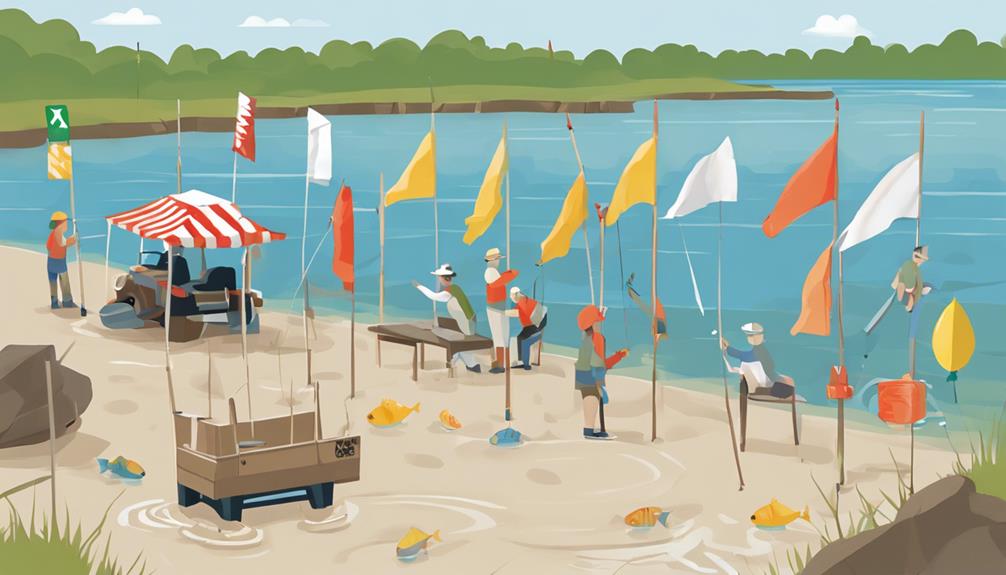
To ensure the fair competition and conservation of fish populations, understanding and adhering to boundary limits and restrictions is imperative in fishing tournaments. Boundary enforcement plays a crucial role in maintaining the integrity of the competition and safeguarding wildlife conservation efforts.
Boundary limits are predetermined geographical areas within which participants are allowed to fish during the tournament. These boundaries are set to prevent overfishing in specific areas and to ensure that all participants have equal access to fishing grounds. Violating these limits can result in penalties or disqualification to maintain a level playing field for all competitors.
Strict adherence to boundary restrictions is vital for the sustainability of fish populations. By limiting the areas where fishing is permitted, tournament organizers can prevent excessive stress on fish habitats and populations. This practice aligns with wildlife conservation principles, promoting responsible angling practices that prioritize the long-term health of aquatic ecosystems.
Effective boundary enforcement requires close monitoring by tournament officials and adherence by all participants. Technologies such as GPS tracking systems and on-water patrols are commonly employed to ensure compliance with established boundaries. By upholding these restrictions, anglers contribute to the preservation of marine environments and the promotion of ethical fishing practices within the competitive framework of fishing tournaments.
Time Limitations for Fishing
Time constraints in fishing tournaments play a crucial role in regulating the competition and ensuring equal opportunities for all participants. Adhering to specific time limitations not only adds an element of challenge to the event but also tests the competitors' fishing technique and competition strategy. To excel within these time constraints, anglers must carefully plan their approach, considering factors like catch documentation and efficient time management.
- Pressure Cooker Environment: The ticking clock creates a pressure cooker environment, pushing anglers to make quick decisions and adapt their strategies on the fly.
- Thrill of the Chase: Racing against time adds an exhilarating element to the tournament, fueling the competitive spirit and driving participants to give their all.
- Time as the Ultimate Adversary: In this race against time, anglers mustn't only outsmart the fish but also battle against the relentless ticking of the clock, making every moment count in their quest for victory.
Effective time management is paramount in these tournaments, as every minute lost could mean missing out on a potential winning catch. Anglers must find a balance between speed and precision, maximizing their efficiency without compromising on the quality of their fishing technique. As the seconds tick away, the true champions emerge, showcasing not only their angling skills but also their ability to thrive under the intense pressure of time constraints.
Prohibited Bait and Lures
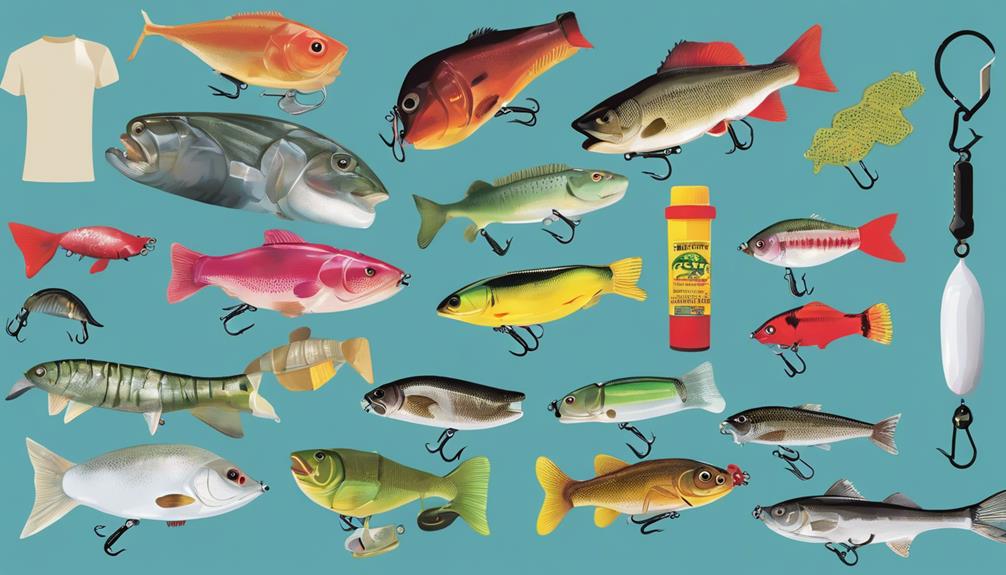
Navigating the rules of fishing tournaments demands meticulous attention to the regulations governing the use of specific baits and lures. Prohibited techniques in fishing tournaments often include the use of live bait due to its potential to disrupt the natural ecosystem of the fishing area. Live bait can introduce non-native species or diseases, impacting the balance of the aquatic environment. To prevent this, tournament rules frequently prohibit the use of live bait to protect the local wildlife and maintain the integrity of the competition.
In place of live bait, anglers are encouraged to utilize artificial lures or baits. Artificial lures come in various shapes, sizes, and colors, mimicking the appearance of natural prey to attract fish effectively. These lures are designed to be enticing to fish while minimizing harm to the environment. Additionally, artificial baits offer anglers a more sustainable and environmentally friendly option for fishing tournaments.
When faced with regulations prohibiting certain bait and lures, anglers should familiarize themselves with alternative methods that comply with tournament rules. By embracing the use of artificial lures and baits, anglers can still enjoy the thrill of the sport while adhering to the guidelines set forth to protect the aquatic ecosystem and ensure fair competition.
Code of Ethics for Anglers
Adhering to a strict code of ethics is essential for anglers participating in fishing tournaments to maintain integrity and respect for the sport. Ethical behavior and a sportsmanship attitude are fundamental not only for the individual angler but for the fishing community as a whole.
Here are some key points to consider:
- Respect for the Environment: As an angler, it's crucial to respect the natural environment where you fish. Dispose of trash responsibly, avoid harming non-target species, and follow all regulations to preserve the ecosystem for future generations.
- Honesty and Integrity: Upholding honesty and integrity is paramount in fishing tournaments. Always abide by the rules, accurately report your catches, and avoid any form of cheating or unethical behavior.
- Courtesy and Fair Play: Displaying courtesy towards fellow anglers and tournament officials, as well as practicing fair play, is essential. Treat others with respect, help promote a friendly atmosphere, and compete with a spirit of fairness and sportsmanship.
Disqualification Criteria
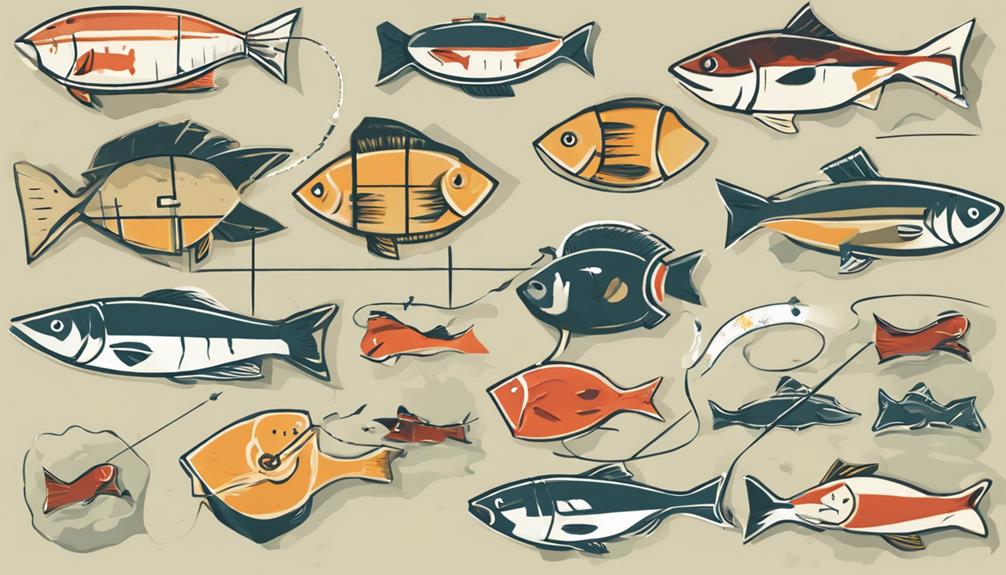
In fishing tournaments, anglers face disqualification if found in violation of the established rules and regulations governing the competition. The disqualification process is crucial in maintaining the integrity of the tournament and upholding fair play and sportsmanship standards.
The disqualification process typically involves thorough investigations into any alleged violations. Anglers may be disqualified if they're found to have used prohibited equipment, violated catch limits, or engaged in unsportsmanlike conduct. To ensure fairness, there are often procedures in place for anglers to protest their disqualification. These protest resolution mechanisms allow for a formal review of the decision, ensuring that any disqualifications are justified and in accordance with the rules.
Fair play and sportsmanship standards play a significant role in fishing tournaments. Anglers are expected to conduct themselves ethically, showing respect for their fellow competitors, the environment, and the tournament officials. Any actions that go against these principles can result in disqualification from the tournament. It's essential for anglers to familiarize themselves with the rules and regulations of the competition to avoid unintentional violations that could lead to disqualification. Remember, adherence to the rules isn't just about winning but also about maintaining the spirit of the sport.
Spectator Interference Policies
To uphold the integrity of fishing tournaments and ensure fair competition, strict policies are in place to address any interference by spectators during the event. Spectator behavior plays a crucial role in maintaining the competitive spirit and fairness of fishing tournaments.
Here are some key points related to spectator interference policies:
- Respect Tournament Rules: Spectators are expected to familiarize themselves with the tournament rules and regulations regarding their conduct during the event. Any violation of these rules may lead to penalties or removal from the premises.
- Crowd Control Measures: Proper crowd control is essential to prevent interference with participants. Spectators should maintain a safe distance from the fishing areas and avoid any actions that could disrupt the anglers' concentration.
- Event Etiquette: It's important for spectators to demonstrate good sportsmanship and respect towards all participants. Cheering and support are encouraged but shouldn't escalate to a level where it hinders the anglers' performance.
Weather-Related Contingency Plans
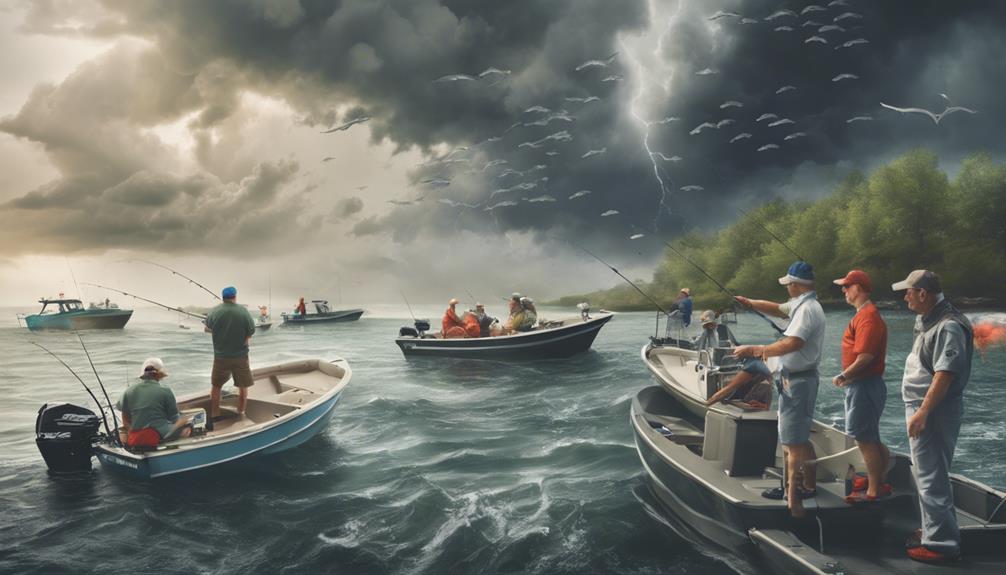
When preparing for fishing tournaments, organizers must establish comprehensive weather-related contingency plans to address potential disruptions caused by adverse weather conditions. Weather monitoring is a critical aspect of these plans, with organizers using advanced forecasting tools to track weather patterns accurately. Safety protocols should be in place to ensure the well-being of participants in case of severe weather conditions. Contingency planning involves having predefined actions based on different weather scenarios, such as delaying the tournament start, relocating to a safer area, or even suspending the event if conditions pose a significant risk.
Communication strategies are essential to ensure that all participants are informed promptly and clearly about any changes due to weather conditions. Organizers should have reliable communication channels in place to reach out to participants, including emergency contact information for all involved. It's crucial to establish a chain of command for decision-making during weather-related emergencies, clearly defining who's the authority to make critical calls.
Prize Distribution Guidelines
Developing a meticulously structured framework for the allocation of prizes in fishing tournaments is crucial for ensuring fairness and transparency among participants. Prize distribution plays a significant role in the overall success and integrity of the competition. When it comes to distributing prizes, adherence to tournament rules and regulations is paramount to maintain credibility and uphold the spirit of sportsmanship.
In the realm of prize distribution, certain guidelines must be followed to guarantee a seamless process that benefits all participants. Here are some key points to consider:
- Transparency: Clearly outline how prizes will be distributed based on placement or categories to avoid any confusion or disputes among participants.
- Equity: Ensure that the prize distribution is fair and proportional to the entry fees or level of sponsorship received, allowing all competitors an equal chance at receiving rewards.
- Sponsorship Impact: Acknowledge the role of sponsors in prize distribution and adhere to any stipulations or requirements they may have regarding the allocation of prizes.
Tournament Protest Procedures
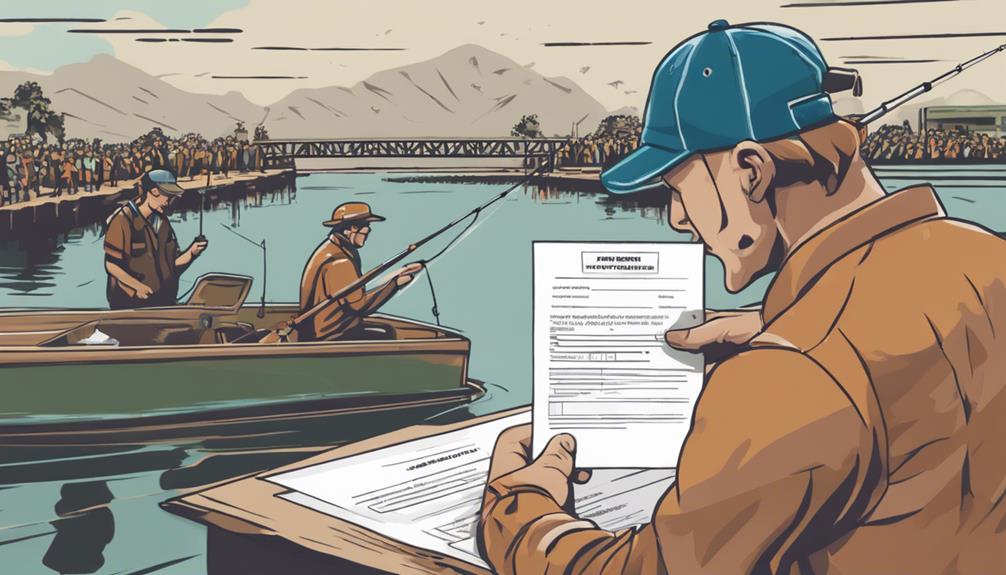
Initiate the process for handling tournament protests by establishing clear guidelines for participants to follow in case of disputes. When a protest arises during a fishing tournament, it's crucial to have a structured system in place to ensure fair and timely resolution. Angler conduct plays a significant role in how protests are handled, and it's important for participants to adhere to the rules and regulations set forth by the tournament organizers.
Protest resolution begins with the angler submitting a formal protest to the tournament officials. This protest should clearly outline the issue at hand and provide any relevant evidence to support the claim. Once the protest is received, the tournament officials will investigate the matter thoroughly. This may involve reviewing witness statements, examining photographic or video evidence, and consulting with any relevant parties.
During the protest resolution process, it's essential for all anglers involved to maintain a professional and respectful demeanor. Disputes should be handled in a civil manner, and all parties should cooperate fully with the investigation. Failure to follow these guidelines may result in penalties or disqualification from the tournament.
Frequently Asked Questions
Can Anglers Use Drones to Scout for Fish During the Tournament?
Yes, anglers can use drones to scout for fish during the tournament.
Drones are effective scouting techniques that provide a bird's-eye view of the water, aiding anglers in fish location techniques.
By utilizing drones, anglers can cover larger areas efficiently, identify fish concentrations, and strategize their fishing approach.
This modern technology enhances the angler's ability to locate fish in different parts of the water body, ultimately increasing their chances of a successful catch.
Are Kayaks Allowed as a Means of Fishing in the Competition?
Yes, kayaks are permitted for fishing in the tournament. However, there are kayak restrictions and safety regulations in place to ensure fair competition and the well-being of participants.
It's crucial to adhere to these guidelines to prevent any accidents or rule violations during the event. Make sure to familiarize yourself with the specific rules regarding kayak usage before entering the competition.
Is Chumming Allowed to Attract Fish to a Specific Area?
Chumming regulations dictate the use of fish attraction techniques in fishing tournaments. This practice involves dispersing bait or fish parts to lure fish to a specific area. While chumming can be an effective method to attract fish, it's essential to adhere to tournament rules regarding its usage.
Understanding the chumming regulations ensures fair play and compliance with competition guidelines. Always consult tournament officials for specific guidelines on fish attraction techniques like chumming.
Can Participants Use Underwater Cameras to Locate Fish?
Yes, you can use underwater cameras to locate fish effectively during tournaments.
By employing fish location_strategy with underwater cameras, you can observe fish behavior in their natural habitat.
This method allows you to identify prime fishing spots and make informed decisions based on real-time visuals.
Utilizing underwater cameras enhances your chances of targeting specific species and optimizing your fishing strategy for a successful tournament experience.
Are Electronic Fish Finders Permitted During the Tournament?
Yes, during the tournament, electronic fish finders are allowed, but with specific limitations. Sonar usage is permitted up to a certain frequency to prevent unfair advantages.
GPS tracking is also allowed but with restrictions on real-time mapping to ensure fair competition.
These regulations aim to maintain a level playing field for all participants while still utilizing technology to enhance the fishing experience.
Conclusion
In conclusion, adherence to the key rules and regulations outlined in fishing tournaments is paramount to ensure fair competition, safety, and conservation of fish populations. By following these guidelines, participants can contribute to the integrity and success of the tournament.
It's essential to familiarize oneself with the specific requirements of each tournament to avoid disqualification and uphold the principles of sportsmanship in the sport of fishing.
